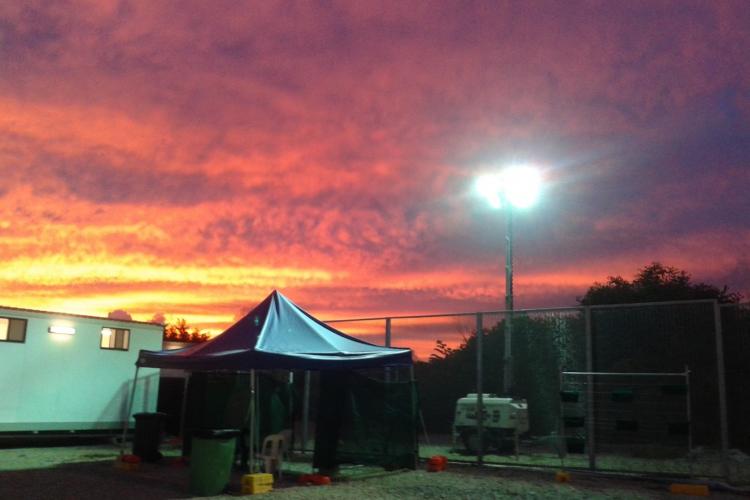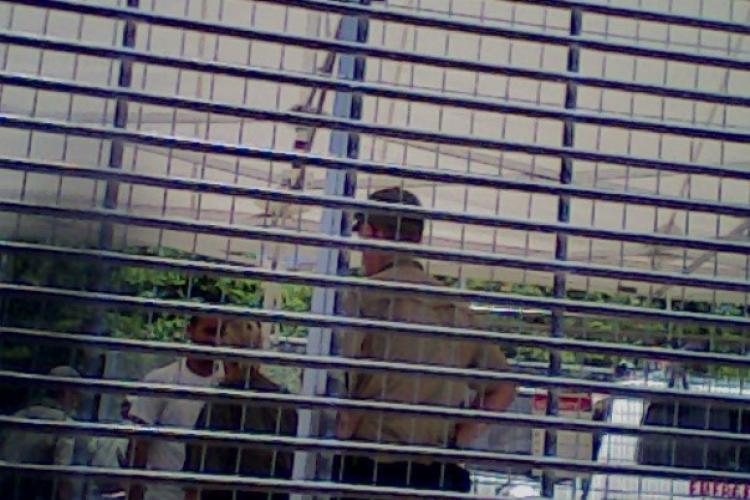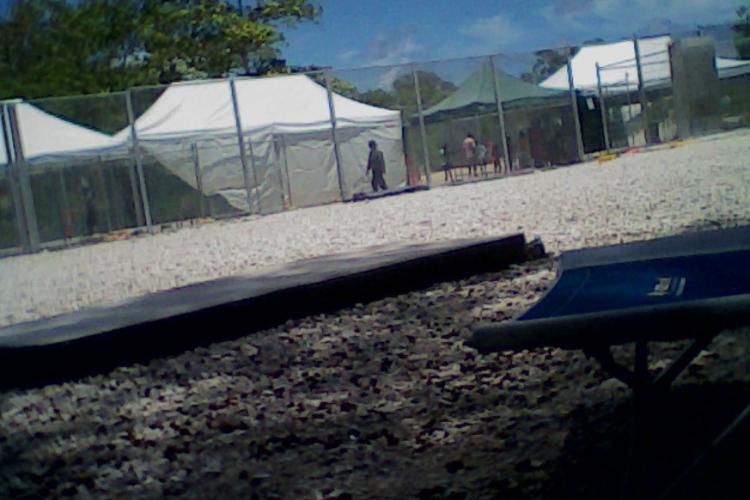“Searching for Aramsayesh Gah” – A Film about Borders, Violence and Imagining an Abode for Serenity
Posted:
Time to read:
Guest post by Ellie Shakiba (with Omid Tofighian). Elahe Zivardar, aka Ellie Shakiba, is an Iranian artist, architect, videographer, photographer and documentary maker who was imprisoned by the Australian government in Nauru from 2013-2019. She was accepted as a refugee by the US in 2019 and currently lives and works in Los Angeles, California. During her detention in Nauru, she was highly active in using photography and video to document the horrific treatment and conditions endured by people seeking asylum and imprisoned offshore, she also used her skills to highlight the impact of Australia’s border regime on the local population. Many of her photos and videos were used widely during the #KidsOffNauru campaign. Elahe has continued to advocate for the freedom of the remaining detainees through her art, including her ‘Border-Industrial Complex’ series of paintings and documentary film projects. Omid Tofighian is an award-winning lecturer, researcher and community advocate, combining philosophy with interests in citizen media, popular culture, displacement and discrimination. He is affiliated with University of NSW, Birkbeck, University of London and University of Sydney. His publications include Myth and Philosophy in Platonic Dialogues (Palgrave 2016); translation of Behrouz Boochani's multi-award-winning book No Friend but the Mountains: Writing from Manus Prison (Picador 2018); and co-editor of special issues for journals Literature and Aesthetics (2011), Alphaville: Journal of Film and Screen Media (2019) and Southerly (2021).
They designed this place to torture us
I am an Iranian artist, journalist, and architect who was illegally detained in Australia's brutal offshore detention centre in the Republic of Nauru.

For six years, under the threat of state-sanctioned retribution, I secretly and anonymously took photos and recorded footage on a contraband phone camera. The photos were made famous during the #KidsOffNauru campaign that evidenced the ongoing detention and abuse of detained children and adults. My reporting revealed the exposure of refugees to asbestos.

But I also noticed a larger trend. Whether it is the outcry over keeping ‘kids in cages’ in America, or the #KidsOffNauru campaign, protests have largely focused on the moral dimensions of arbitrary and cruel detention as they pertain to children and families.
Less attention has been paid to examining the physical dimensions of the prisons themselves, the for-profit industry that builds them, and the specific and unnecessary design choices that make them so harmful and morally abhorrent.

This film can help make systemic changes.
A first-person narrative. A historical document. A creative resistance. An exposé of secrets, trauma, pain, and domination. A short, mixed-media documentary that exposes the architecture of torture, trauma, and exploitation through the legacy of Australia’s infamous offshore processing centers. "No other Australian policy has been so widely condemned by the world’s human rights activists nor so strongly defended by the country’s leaders."
I recorded the largest collection of never-before-seen footage from inside Nauru. Now resettled in Los Angeles, I am using my archives to model the world’s first architecturally accurate 3D simulation of the Australian-run detention centre (officially called the Nauru Regional Processing Centre) and collect testimonies from the men, women, and children who were detained there.

As I explore the detention center and its cruel architecture, I also move through my lingering trauma to propose a radically utopian space of healing, designed years ago when I was an architecture student in Iran, which I call “Aramsayesh Gah" – Farsi for "Abode for Serenity".
"Searching for Aramsayesh Gah" asks us to abolish our detention systems and instead build spaces that promote healing and are free – in every sense. It explores themes such as creative resistance, healing and abolition; it is about struggle and searching for serenity while detained and after release.

We can't do this without your support.
I was resettled in Los Angeles following the controversial U.S.-Australia refugee swap and have been working incredibly hard to digitally construct an accurate 3D model of the detention center on an old computer with unreliable, crashing software. By day, I juggle a difficult job as a COVID-19 contact tracer for the city, now the epicentre of the country's coronavirus outbreak.
Our campaign
Thanks to the support of our incredible community, in a week we have raised just under our initial goal of $16,000. Due to this success, we have increased our goal to USD$45,000 to cover our full production costs. We need your help now more than ever! Please share the campaign and, if you are able, make a contribution today.
We need your help to build early momentum for the project and raise $US45,000 to support us to finish this important work and take the film through development and production. That includes:
- ~$4,500 for a year's subscription for necessary modelling software.
- ~$6,000 set aside to cover extensive translation and transcription services for hours of testimonies from refugees.
- ~$3,000 for on-location equipment rental and production travel.
- ~$750 for delivery of archival footage and ongoing development.
- ~$1,000 for important funds to help finance preventative legal services and insurance.
- ~$5,000 for post-production expenses.
- ~$2,500 for original music.
- ~$500 for research and development.
- ~$750 for miscellaneous production expenses (including rights, office and administration, etc.)
- ~$5,000 for impact engagement.
- ~$1,200 for initial distribution.
- Plus contingency fund and compensation to Ellie and the crew.
Every dollar counts.
The impact.
We've built an impact team of refugees, community leaders, and justice organisations in Australia and the United States to help galvanise a collective movement that focuses on the moral, political, economic and cultural dimensions of border regimes and the role of architecture and design in detaining people seeking asylum.
We believe that this project can be used by journalists, advocates, and teachers to educate and organise people around the world on the trauma of detention, and hope to motivate similar investigations of and actions against prisons, jails, and other carceral institutions.
Impact Partners
- Ads-Up Refugee Network
- Dr. Omid Tofighian – award-winning lecturer, researcher and community advocate; translator of Behrouz Boochani's No Friends But the Mountains: Writing from Manus Prison (Picador 2018)
If you'd like to make a tax deductible donation or want to join our impact team, please reach out to jacob@thismachinemedia.org.
Read about the project in the news: Humanity in Action. "Searching for Aramsayesh Gah" is a production of This Machine Media and is co-created and executive produced by Ellie Shakiba. This Machine Media is a multidisciplinary production company dedicated to sparking civic engagement through documentary storytelling. Learn more here. Connect with us on Instagram and Facebook.
Any comments about this post? Get in touch with us! Send us an email, or post a comment here or on Facebook. You can also tweet us.
__________
How to cite this blog post (Harvard style)
Shakiba, E. (2021). “Searching for Aramsayesh Gah” – A Film about Borders, Violence and Imagining an Abode for Serenity. Available at: https://www.law.ox.ac.uk/research-subject-groups/centre-criminology/centreborder-criminologies/blog/2021/03/searching [date]








